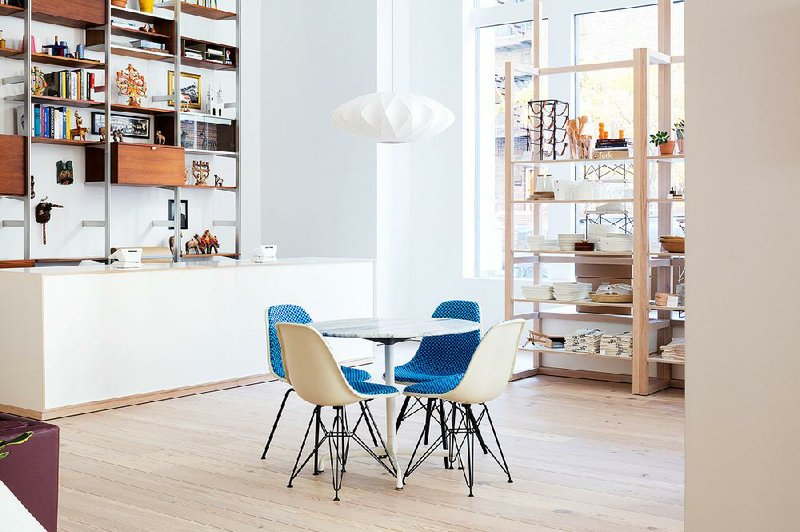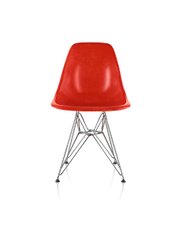The confusion began when I inherited my father's original Eames lounge chair, the sort that has cushioned psychiatrists such as him for decades. He'd bought it with his first big paycheck back in the 1960s, when Charles and Ray Eames, arguably the most famous of American industrial designers, were at their peak -- and still living.
Renovating a house this year, and wishing to furnish it with a similar mid-'50s modern aesthetic, I wanted to buy more items by the Eameses and others I admire, the aesthetic all-stars whose creations are ubiquitous, although you might not know them by name if you are neither an architect nor a design geek: the likes of Isamu Noguchi, Verner Panton, Hans Coray and Jean Prouve. But a quick internet search left me stumped.
Take the iconic Eames DSW chair, also known as the Eiffel chair, which I thought would be nice for our dining room table. I found scores of chairs on various online stores, all labeled and looking identical, but with prices ranging from $44 to $436. Some websites indicated that they sold reproductions, but others did not.
THE REAL DEAL
My first port of call for Eames DSW Eiffel chairs was the nearest official Vitra retailer, a store called Kubus, in Ljubljana, Slovenia, near my home. Store owner Ula Vehovar Kenda told me: "People who wouldn't even think of buying a fake handbag, watch or sunglasses lower their standards dramatically when it comes to furniture. Authorities who very efficiently intercept shipments of counterfeit cigarettes or sports goods see no problem in containers of replicas arriving from the Far East."
The Swiss Vitra firm has long held the license to distribute original Eames chairs in Europe, paying the Eames estate and the original producer of the chair, U.S. firm Herman Miller, for the privilege. These chairs are as the designers intended, aesthetically and materially. But they also cost more than $436 each, which was out of our price range, as we needed six to eight chairs.
I began to explore reproductions and found many similar to the original in aesthetic and, according to reviews, quality. This puzzled me, because I live in Europe, where the European Union ostensibly has strict laws protecting 3-D design, such as furniture, from unlicensed reproduction. The proliferation of copies openly advertised online suggests that the rules are confusing, rife with loopholes and inconsistently enforced. As Ljubljana-based lawyer Metod Zagar said, "Enforcing the rights holder of the design largely resembles tilting at windmills."
Most of the sites advertising reproductions were in the United Kingdom. There are some that were different from the original: The legs were stouter, the bolts were a different color, the impression of the legs, like two dimples, was visible in the base of the seat. Others appeared identical, even when looking at details. For instance, the original DSW Eiffel chairs have a groove in the L-shaped metal bracket that bolts the leg to the base, which is meant to provide extra strength. One reproduction I examined had this, but most did not.
FAMOUS FAKES
My research also turned up some interesting wrinkles. The Guardian published an article about a company called Voga, which sells high-quality, but inexpensive, reproductions. About a year ago, the company closed down in England and moved to Ireland. You can still order from its site, voga.com, but it requires buyers to arrange shipping from a warehouse in Ireland. The Guardian said this is a way to circumvent
strict EU design-protection laws that the United Kingdom is still enforcing. (A new law took effect at the end of January, but Ireland remains exempt from it.)
This issue is hardly unique to the United Kingdom, but there have been some high-profile kerfuffles related to it of late. Former British Prime Minister David Cameron's wife, Samantha, bought a reproduction of Achille Castiglioni's Arco lamp for $312 (originals cost $1,875), prompting the editor of Elle Decoration magazine to call her "cheap, hypocritical and fake" for her support of the "faux-furniture" industry.
But is this so wrong, if a reproduction is labeled as such? In the world of fine art, there is no objection, legal or moral, to one artist producing work that copies another, as long as there is no attempt at fraud: Copies, labeled as such and made by hand, are considered acts of homage rather than theft. In the world of luxury goods, such as Louis Vuitton handbags, the shape of the bag is not what is copyrighted, but the logos are -- a Louis Vuitton-shaped handbag without any of the brand identifiers would be legal to produce. But industrial design, particularly pieces such as the Eames chair, are iconic based on their overall shape and material.
In the United States, the laws appear simpler, but there is much room for interpretation, which can lead to confusion. Although trademarks, logos and patents are protected, University of Oxford law professor Graeme B. Dinwoodie wrote in the IPRinfo online periodical, "the United States doesn't have utility model laws, and it does not grant protection against slavish imitation; in the United States, that's called free competition." As Amsterdam-based lawyer Edgar Tijhuis wrote in the online literary review Versopolis, "This means that firms can indeed approximate the designs of others, though without reproducing trademarked logos and, of course, without trying to pass them off as something they are not."
'VERY UNRELIABLE'
Design patents can be registered, but Dinwoodie says they have proved to be "very unreliable." That is why the Samsung-Apple lawsuit is particularly interesting. In January, the U.S. Court of Appeals for the Federal Circuit reopened the long-standing patent lawsuit that accused Samsung of copying the design of the iPhone, including the shape of the phone and its screen.
The outcome of this suit could set a precedent for future design-related laws, although it remains to be seen whether U.S. laws will shift. Bringing the U.K. law in line with the rest of Europe was partly because of Brexit and partly because of the heavy lobbying of Vitra, which claimed to be losing more than a quarter-billion dollars per year to U.K.-based copies of designs for which Vitra holds exclusive license. The market for these mid-'50s modern objects is enormous. Experts say the reproduction black market will continue to grow; otherwise products such as these would be available only to the wealthy. This is ironic, because the Eameses' goal was to make great design available to the masses.
As an experiment for this article, I bought a promising-looking dining room chair reproduction that the seller assured me was identical to the original, for $97 -- a price I could handle. It looked like the original I had seen in the licensed shop, selling for more than $435. It felt the same, too, when I sat in it. Extremely comfortable, supporting the lower back when sitting upright, giving just the right amount when leaning back. The legs were less elegant and elongated than the originals, and the bolts affixing them to the base were white, rather than black, the L-shaped brackets flat, not grooved. Regular use over time is the only way to determine whether this reproduction is "built to last."
Danish furniture company Fritz Hansen publicly condemned McDonald's for using reproductions of Arne Jacobsen furniture, alongside originals, in its new restaurants. Hansen stopped supplying McDonald's, despite the reported $2 million it earned from the sale of 2,500 chairs, stating that it "could not cooperate with a group that accepted piracy and set aside intellectual property rights." Although its purchases were legal, McDonald's said it wished to avoid bad publicity and is sticking to originals.
At a recent visit to a newly opened McDonald's, I noted that the chairs were Eames DSW Eiffels. While my daughters enjoyed a Happy Meal, I surreptitiously flipped over a chair. Grooved brackets, black bolts. An original.
HomeStyle on 05/13/2017

